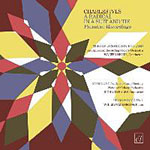Home » Jazz Articles » Album Review » Charles Ives: A Radical In a Suit and Tie
Charles Ives: A Radical In a Suit and Tie
It's not difficult to see how this music influenced the likes of Frank Zappa and Van Dyke Parks; but on a profound level, the influence should not be overplayed, as it works to the detriment of all three figures. Besides which, Ives' take on Americana, encompassing as it does the evangelical hymns and dance hall melodies of his day, is definitively his own.
This is abundantly obvious on "Three Places in New England." Whilst the melodic—and particularly, the harmonic—vocabulary of all three pieces is notable for its individuality, it's Ives' use of those discovered sources referred to above that lifts the pieces into a realm of their own. In particular, "General Putnam's Camp, Redding, Connecticut," simultaneously rife with multiple traditions as it is, is a working definition of Ives' inclusiveness.
His music seems to have never been written purely for effect, however, and that fact throws his individuality into stark relief. This is borne out by his writing for strings— particularly in his Symphony No. 3. In the movement entitled "Old Folks Gatherin,'" he seems almost to flirt with the Romantic tradition before abandoning it in favor of his own distinctive, vaguely chromatic vocabulary.
In the reduced form of the piano sonata, it's almost as if he predates Morton Feldman's way with unstill, unsettled moods, albeit with a harmonic sense that Feldman's work doesn't possess. This is particularly true of the "Adagio con Molto," where the impression is of Ives acknowledging external musical developments before settling back upon his own rich, nuanced vocabulary. Regardless of how idiosyncratic that vocabulary might be, pianist William Masselos is alert to every implication of it, and such are his skills as an interpreter that it's as if his very touch serves a rhetorical purpose.
It could be argued, albeit largely in the spirit of clutching at straws, that Ives's music is as singular as that of Erik Satie; but the point offers nothing in the way of insight. Outside of any tradition as such at the same time as it took in and incorporated many traditions, Ives's music sounds as singular as it did upon its creation and original performance.
Track Listing
Three Places in New England (1903-1914): The "Saint Garden" in Boston Common (Col. Shaw and His Colored Regiment); General Putnam's Camp, Redding, Connecticut; The Housatonic At Stockbridge. Symphony No. 3: The Camp Meeting (1904-1911): Old Folks Gatherin' (Andante Maestoso); Children's Day (Allegro); Communion (Largo). Piano Sonata No. 1: Adagio con Molto; Allegro Moderato; Largo: Allegro; Allegro; Andante Maestoso.
Personnel
Charles Ives
composer / conductorThe American Recording Society Orchestra, Walter Hendl, Conductor (1-3); National Gallery Orchestra, Richard Bales, Conductor (4-6); William Masselos: piano (7-11).
Album information
Title: A Radical In a Suit and Tie | Year Released: 2008 | Record Label: Unknown label
< Previous
Trace A River
Next >
Through My Eyes
Comments
Tags
For the Love of Jazz
 All About Jazz has been a pillar of jazz since 1995, championing it as an art form and, more importantly, supporting the musicians who create it. Our enduring commitment has made "AAJ" one of the most culturally important websites of its kind, read by hundreds of thousands of fans, musicians and industry figures every month.
All About Jazz has been a pillar of jazz since 1995, championing it as an art form and, more importantly, supporting the musicians who create it. Our enduring commitment has made "AAJ" one of the most culturally important websites of its kind, read by hundreds of thousands of fans, musicians and industry figures every month.



















